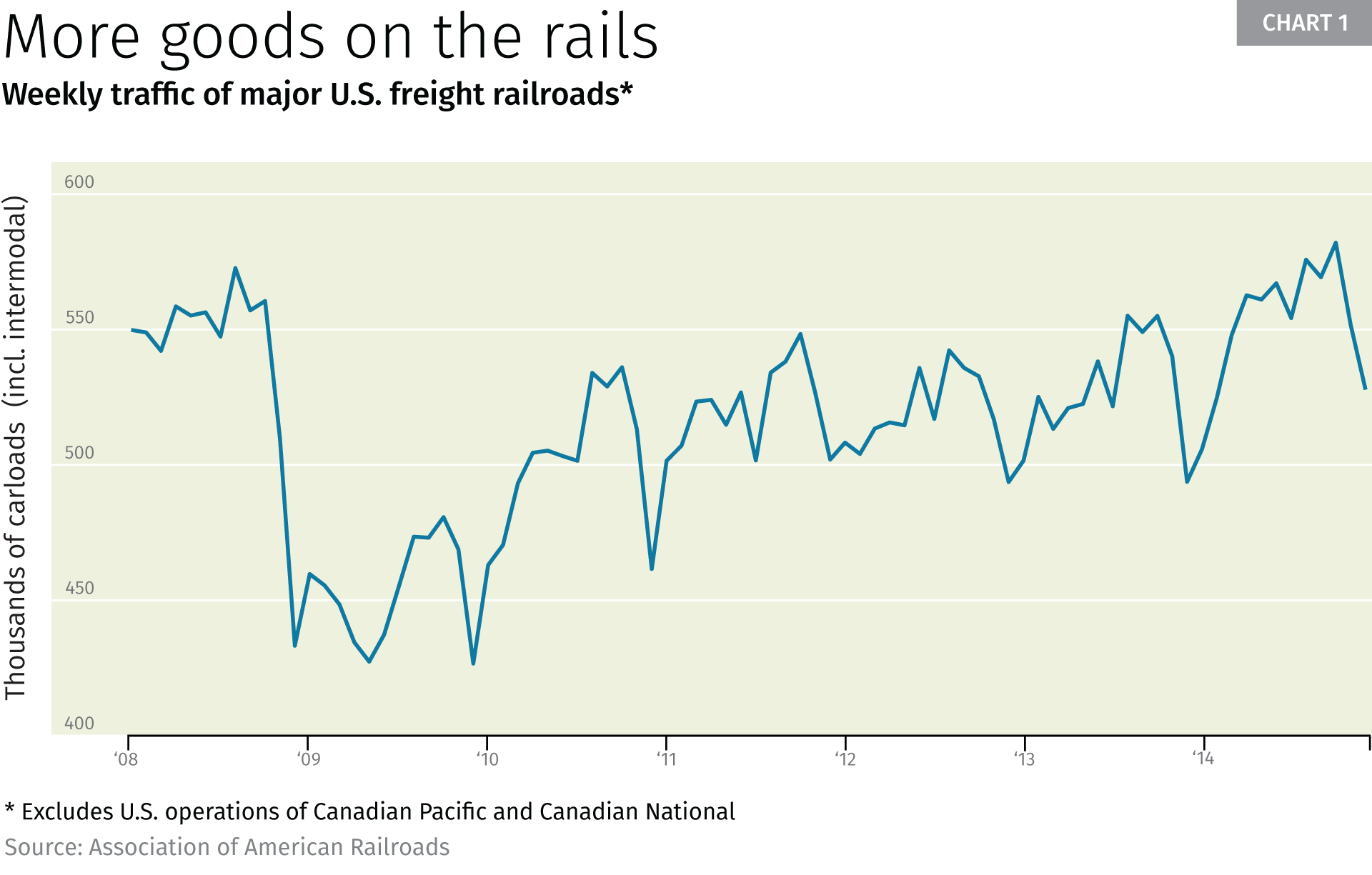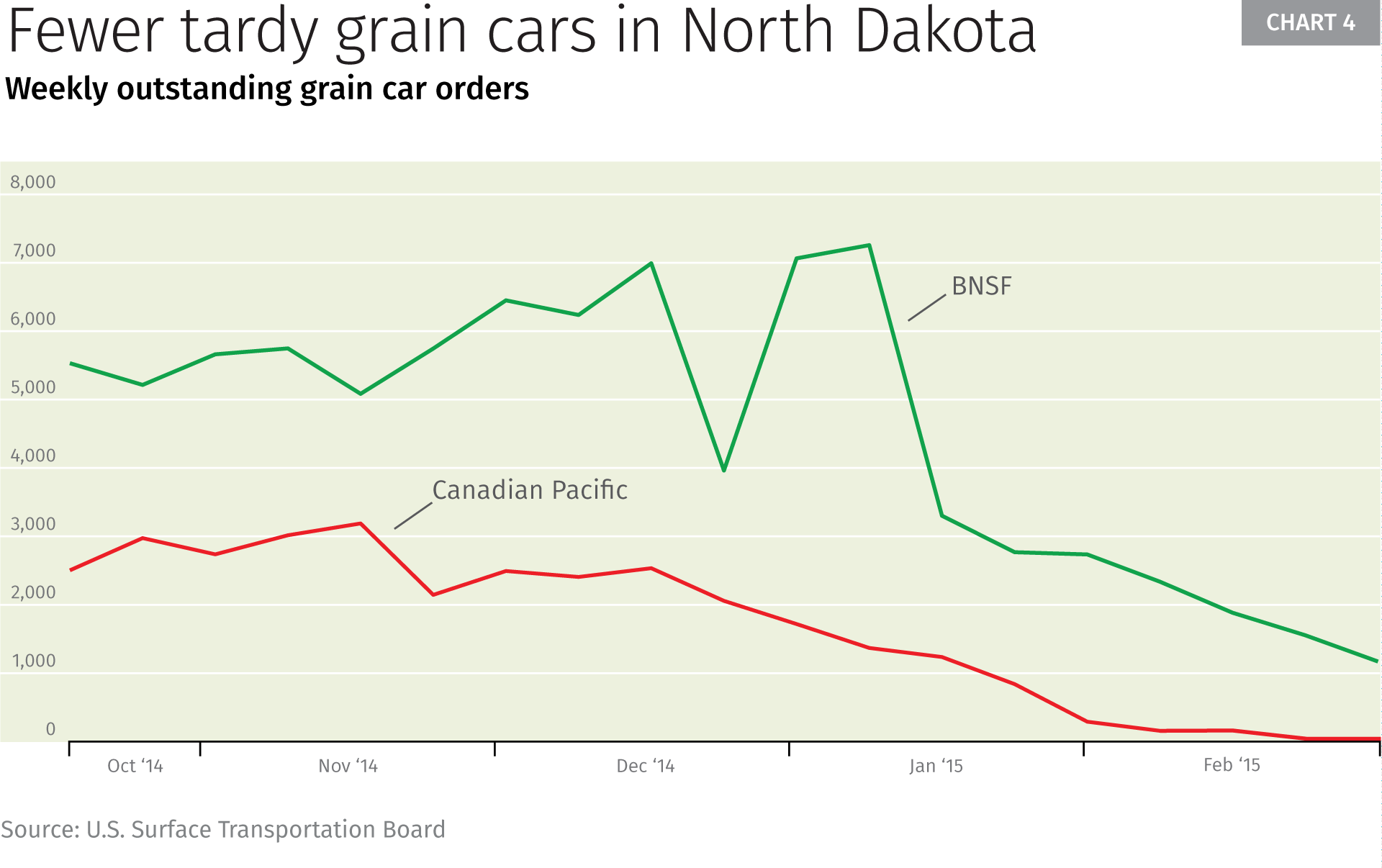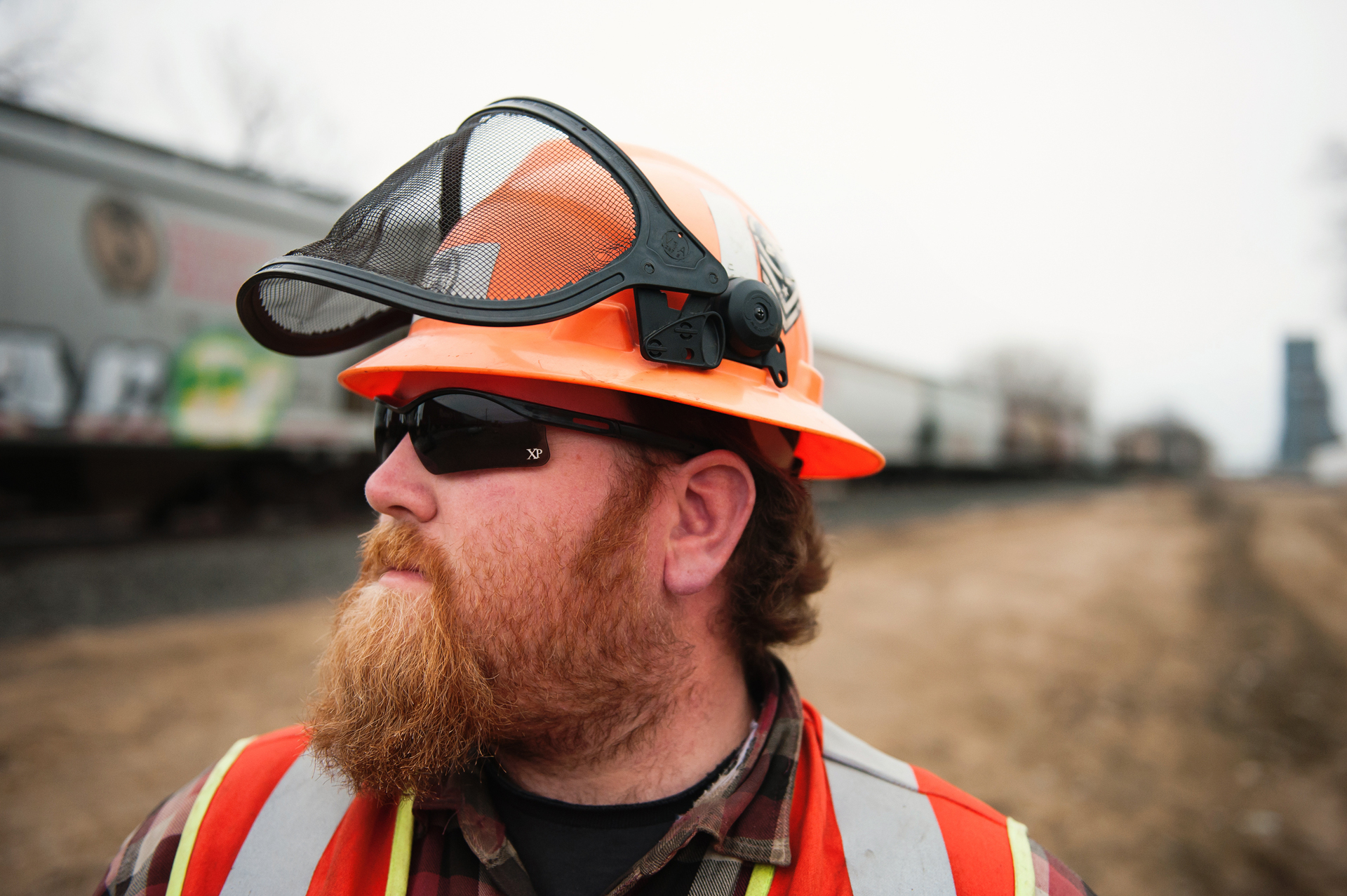Video: fedgazette senior writer Phil Davies on railroads in the Ninth District
The Quick Take
Responding to widespread rail service disruptions in 2013 and 2014, freight railroads serving the Ninth District have made robust investments in infrastructure, equipment and personnel. Much of this spending has happened in North Dakota, where crude oil shipments have risen dramatically. Rail congestion eased last winter, partly due to a seasonal drop in overall freight traffic. But railroad supply is likely to continue playing catch-up with demand for a while. Railroads expect more business this year in an expanding U.S. economy, although lower oil prices may cut shipments of Bakken and Canadian oil. Potential constraints on increasing rail capacity include ongoing construction work, a backlog of orders for new railcars and proposed safety rules for tank cars.
Thomas Walsh likens the freight rail network to a giant conveyor belt in a factory or warehouse. A smoothly running loop made up of a series of smaller links delivers parts or finished goods efficiently to their destinations, but “if you stop or slow the conveyor [at any point], you’re going to have problems all across the system,” said Walsh, president of Montana Rail Link (MRL),* a regional railroad based in Missoula, Mont.
Last year, the railroad conveyor in the Ninth District slowed markedly; freight moved haltingly, often making unscheduled stops and taking long detours to avoid bottlenecks. “Railroads in general, especially in the northern tier of the U.S., have really struggled with capacity over the last couple of years,” Walsh said.
But rail conditions can change rapidly, often unexpectedly. Over the winter, freight was flowing more freely than it had for much of last year, when farmers, oil companies, electric utilities and other shippers were complaining openly about poor service and higher freight costs.
Some rail customers, such as grain elevators shipping in small quantities and Amtrak passengers, were still frustrated by slow or inconsistent service. But there was a sense that the crisis had passed, with service returning to more normal levels. Compared with last fall, fewer trains were delayed, and fewer farmers were paying a premium for space on grain trains. A January survey of grain elevators in Minnesota, Nebraska and the Dakotas by a trade association for soybean shippers found that rail service had improved significantly since last fall.
One reason congestion eased was a seasonal drop in rail traffic; another was low crop prices, which induced many farmers to store their grain after the fall harvest rather than ship it to market. But robust railroad investment also played a role in reducing rail delays and costs. In 2014, railroads serving the district—primarily major railroads such as BNSF Railway and Canadian Pacific Railway, but also a number of regional and local railroads—spent hundreds of millions of dollars to expand their capacity by laying new track, acquiring additional rolling stock and hiring workers. Much of this investment occurred in North Dakota, whose thin rail infrastructure has been strained by swelling crude oil shipments over the past half-decade.
Just as a mile-long freight train takes a while to pick up speed, it can take months for such investments to raise overall service levels. Anthony Hatch, a railroad industry consultant based in New York City, sees concerted efforts to boost capacity that began in 2013 finally bearing fruit for U.S. railroads and their customers. “Everybody increased their capital; everybody increased personnel,” he said. “Those people, those locomotives, that extra work are starting to have an impact today, and they’re going to have a bigger impact every single day as more capacity is added.”
However, future rail demand is difficult to predict; many sources fretted last winter that severe rail congestion would redevelop if grain shipments rose sharply in the spring. “I understand that farmers are waiting for a more favorable price climate, that’s natural,” said Mike Steenhoek, executive director of the Soy Transportation Coalition (STC). “But if and when they do sell, will rail be in a position to handle that?”
Matching railroad supply to demand in the region is likely to remain a work in progress for at least the next two years. The industry projects rising freight volume in a burgeoning U.S. economy this year. Continuing efforts to increase rail capacity in the district to accommodate that growth must cope with traffic disruptions caused by infrastructure projects as well as potential constraints on expansion. Those constraints include backlogged orders for new railcars and pending federal regulations that will require replacement or refitting of tank cars used to transport oil and other flammable liquids.
Complicating any forecast of rail conditions this year is the outlook for crude oil production in the Bakken oilfields, which fell slightly in January. A sharp drop in the price of oil since last summer will likely curtail oil shipments, freeing up capacity for other commodities. But it’s not clear when this will occur and how much crude-by-rail volume will fall.
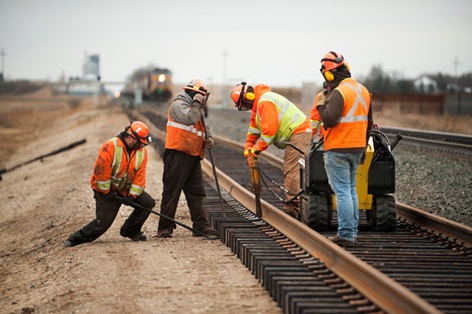
A Canadian Pacific work crew drives spikes into rail ties on a new stretch of track near Wyndmere, N.D.
(Photo by Dean Riggott)
Slow train coming
Rail traffic has increased nationwide since the Great Recession, when shipments of all kinds of goods plummeted. Between 2010 and 2014, freight carried by major U.S. railroads rose 21 percent, according to data compiled by the Association of American Railroads (see Chart 1). Shipments of forest products, metallic ores and motor vehicles rose, and there was huge growth in petroleum products, including crude oil (Chart 2).
Last year, crude oil amounted to less than 3 percent of U.S. rail volume. But crude’s share of rail traffic has risen rapidly, and most of that growth has occurred in the Upper Midwest. From 2009 to 2014, crude oil production from the Bakken formation in North Dakota and Montana grew almost sixfold to about 1.2 million barrels a day. Because of limited pipeline capacity (see the April 2013 fedgazette), about 60 percent of that oil moves by rail, according to the North Dakota Pipeline Authority.
Crude-by-rail shipments on Canadian Pacific and BNSF—the major railroads directly serving the Bakken oilfields—have surged in recent years; last year, Canadian Pacific oil shipments rose 22 percent, and BNSF carloads of petroleum products increased 12 percent through October compared with the first 10 months of 2013. The two railroads’ lines spanning the Great Plains also carried increasing amounts of oil development-related materials such as drilling pipe, frac sand and cement.
Beginning in the fall of 2013, rising crude oil shipments contributed to widespread disruption in rail shipments across the region. Invoking the metaphor of the “perfect storm,” railroad executives pointed to a bumper corn and wheat harvest in the northern plains in 2013, and the bitter winter of 2013-14 as exacerbating factors in rail congestion that persisted through most of last year.
The backups affected shippers across the economic spectrum.
For farmers, rail problems meant slimmer profits. A University of Minnesota study found that rail delays cost Minnesota corn, soybean and wheat growers about $100 million in the spring of 2014. Reduced rail capacity raised shipping costs for elevators and food processors, which passed along those charges to farmers. Growers in northwestern Minnesota fared the worst because they have few shipping options besides rail. The region has no large rivers for barge transport, and “you can only go so far with a truck,” noted University of Minnesota grain marketing economist Edward Usset, who directed the study.
A contemporaneous North Dakota study indicated that crop producers lost roughly $67 million in revenue due to higher rail rates.
Obliged to deliver grain to processers by a certain date, elevators faced with tardy trains bid up prices in the secondary market for shuttle train railcars—space on grain trains of 100 cars or more that is initially booked by large grain companies and traded among shippers (see Chart 3).
Slow rail service forced other shippers to adopt workarounds, often at higher cost. Last fall, delayed BNSF coal deliveries led Minnesota Power, an electric utility in northeastern Minnesota, to idle four coal-fired generators to conserve coal. To make up for reduced power generation, the utility bought $27 million in higher-priced electricity on the spot market. “We wanted to make sure that we had enough coal as we headed into the winter months, when prices on the market are even higher,” said Minnesota Power spokeswoman Amy Rutledge.
As a result, the state’s iron mines, which are heavy electricity users, bore an estimated $8 million in extra power costs. And last October, erratic BNSF rail service prompted Hibbing Taconite to take the expensive step of hauling taconite pellets by truck to Duluth-Superior Harbor to supply steel makers on the lower Great Lakes.
Rail congestion also sowed havoc for Amtrak passenger trains, which run on routes owned by freight railroads. In fiscal 2014, ridership on the Empire Builder train from Chicago to Seattle fell 19 percent. In an attempt to bypass congestion, Amtrak diverted the westbound Empire Builder onto an alternate BNSF line, dropping stops at Grand Forks, Devils Lake and Rugby, N.D.
In October, after a series of public hearings about rail service problems, the U.S. Surface Transportation Board (STB) declared that “service disruptions have hindered nearly all carriers” and ordered major railroads to submit detailed weekly reports on their on-time performance.

Canadian Pacific's rail yard in St. Paul is a major junction for trains carrying crude oil, grain and other commodities to destinations in the district and across the country.
(Photo by Dean Riggott)
Sweating the assets
Public furor over intense congestion came after freight railroads had already started to ramp up their capital investments to cope with increased traffic. Last year, the railroads redoubled their efforts to improve service.
Of the four major (or Class 1) railroads serving the district (see map), BNSF has invested the most in tackling rail delays. Across its 28-state network, BNSF spent $5.5 billion maintaining and enhancing its physical assets last year—a record amount of capital investment by the company, for the third year running. Capital spending included $1.6 billion to add more than 600 engines to its locomotive fleet and buy or renew leases on 5,000 railcars.
Related content
Battling backups
Railroad capacity improvement projects in the Ninth District
The little railroads that could
Not your father's railroad
Rail expansion efforts include spending on innovations that make freight trains safer and more efficient
“BNSF is way ahead [of other railroads] there,” said David Vernon, a railroad industry analyst at Sanford C. Bernstein & Co. in New York. “They’re spending a huge amount of capital right now to add resources to the network and bring service levels back up.”
Canadian Pacific, a smaller railroad whose trains carry a lot of oil produced in western Canada, spent an estimated $1.3 billion on its North American network in 2014, slightly more than the year before.
BNSF and Canadian Pacific can afford large outlays for maintenance and expansion—for both railroads, at least 20 percent of revenue in 2014—because of rising freight revenues and healthy profits. Last year, Canadian Pacific’s sales increased 8 percent to an all-time high of $6.6 billion, yielding record earnings per share.
Belying the image of trains as 19th century “iron horse” technology, much of recent capital spending by railroads has gone toward centralized traffic control and other technology designed to move trains more efficiently and safely (see “Not your father's railroad”).
In the district, BNSF spent roughly $800 million on capital projects in 2014. In North Dakota, $400 million worth of investment included laying 55 miles of double track from Minot west through the heart of the oil patch and building more sidings—stretches of track next to the mainline that allow one train to pull off to make way for another headed in the opposite direction—on predominantly single track routes serving Bismarck and Fargo.
In Montana, BNSF spent $160 million to install extra track at train yards in Glendive and west of Miles City, extend sidings at several stations and implement automated train control systems.
Canadian Pacific has released less information about its investments in the district. But the railroad has said it planned to spend $150 million from 2014 through 2016 on siding extensions, technology upgrades and other improvements along its mainline from the Canadian border near Minot south to Chicago. A big project in Minnesota last summer involved rerouting trains through the Twin Cities to avoid congestion on BNSF tracks used by Canadian Pacific trains; the work cut travel time for westbound trains by more than an hour.
Canadian Pacific has emphasized making the most of its existing rolling stock rather than acquiring more locomotives and railcars, which can worsen congestion. “If you’re on a freeway, and things are jammed up, the last thing you want to do is put more cars on the road,” said John Brooks, vice president of marketing and sales for the railroad’s bulk business. “Job one is to sweat the assets and create as much velocity as we can in the infrastructure we have.”
Rail congestion over the past two years was less serious on the Union Pacific Railroad and Canadian National Railway. In the district, these Class 1 railroads serve areas of the district that lie outside main rail corridors for crude oil. But over the past three years, Omaha-based Union Pacific has invested in additional capacity to handle rising frac sand shipments from mines (see the July 2012 fedgazette) in Minnesota and Wisconsin. Last year, the railroad spent $130 million on new sidings, signaling systems and other capacity improvements in the two states.
In addition to investing in capital, district Class 1 railroads have built up their workforces in order to move more railcars and cope with logjams when they occur. Last year, Canadian Pacific hired 170 train and engine employees in North Dakota and added another 70 in Minnesota. Union Pacific hired an additional 86 workers in Minnesota and Wisconsin in 2014.
Historically, railroads have had little trouble attracting workers; unionized train and yard crews receive generous wages and benefits. But hiring has been difficult in North Dakota because of very low unemployment and high wages in the oil industry. To recruit workers in the state, Canadian Pacific has offered signing bonuses and provided free accommodations to new hires for up to six months.
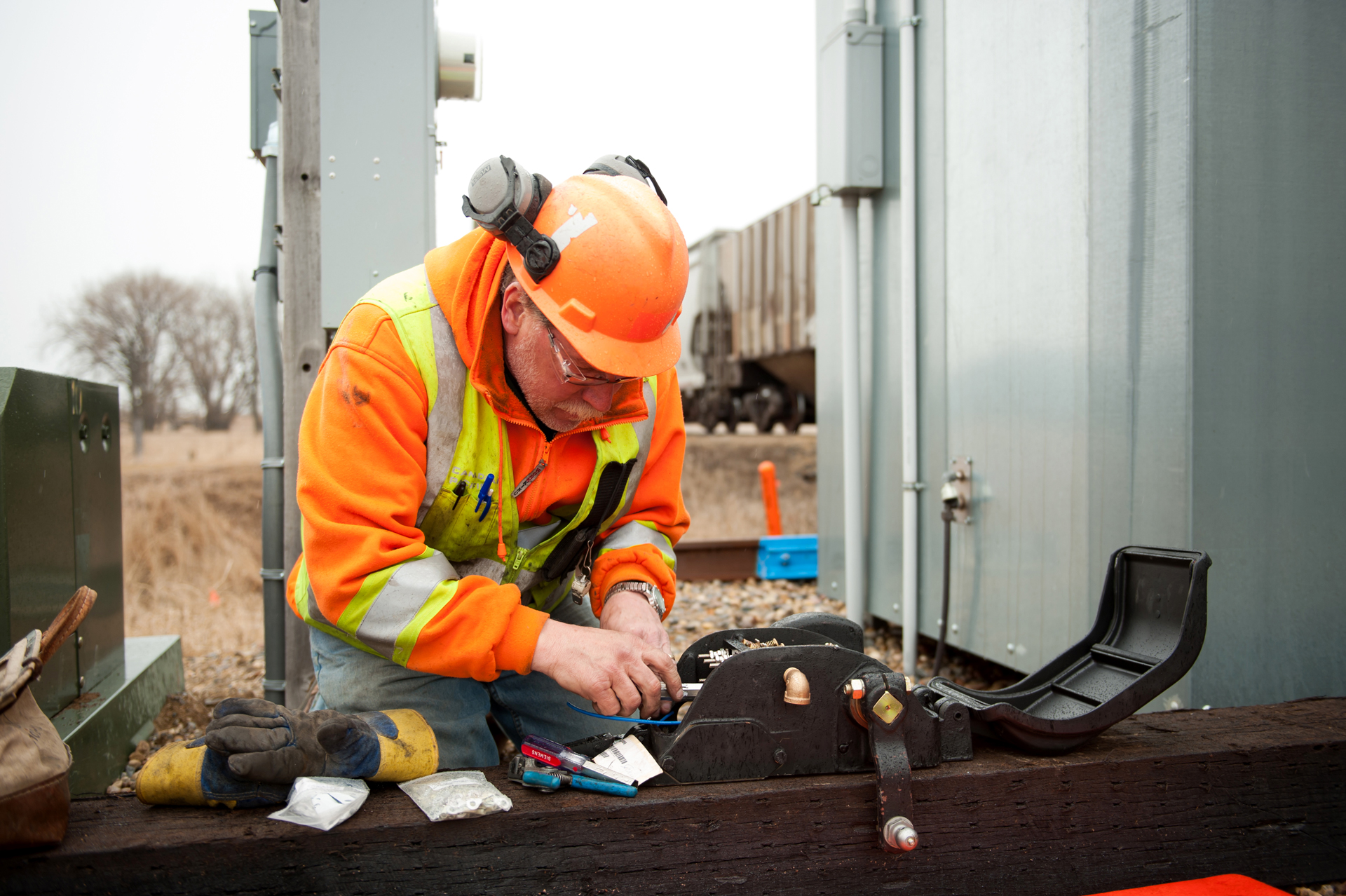
Canadian Pacific assistant signalman Mark Hasen wires a switch circuit controller as part of the installation of centralized traffic control near Hankinson, N.D. (Photo by Dean Riggott)
Calm before the storm?
Service on the Ninth District rail system improved considerably over the winter. Data on railroad performance in district states are scant; for the most part, metrics like average train speed and station wait times apply to railroads’ entire operations, not to specific areas of their networks. However, STB on-time performance reports show that in North Dakota, fewer railcars were arriving late to their destination after the first of the year (see Chart 4).
Bids for shuttle train cars on BNSF’s secondary market provide further evidence for an easing of congestion; offers began a steep downward slide in November.
In the farm sector, complaints about poor rail service ebbed as the weather grew colder. In the STC’s January survey, all 42 elevators canvassed said that shuttle train cycle times—the number of turns per month between origin and destination—were faster than a year ago. In early November, only 67 percent of elevators reported quicker turnarounds. In addition, in the January survey the number of elevators reporting late railcars had halved over the past two months. Some of this easing can be attributed to seasonal fluctuations in traffic. Typically, rail shipments of commodities such as grain, coal and metal ores drop during the winter months. Last winter, low crop prices accentuated this dip by keeping hundreds of millions of bushels of crops in storage after the fall harvest.
“Certainly one of the reasons rail service has been better than expected thus far with the 2014 harvest has been the fact that farmers have been storing a considerable amount of grain, particularly corn, and so that has resulted in less of a surge on the rail network,” said Steenhoek of the STC.
But efforts to increase capacity by railroads big and small likely contributed to freer flowing traffic. Rail service in the district improved despite a year-over-year increase in U.S. rail volume and heavy traffic on some parts of the system. In December, despite near-record freight volumes for the company, train speeds on the MRL network were 17 percent higher year-over-year for some types of traffic, Walsh said.
However, for some rail users, trains still weren’t moving fast enough last winter. According to the STB, North Dakota was still seeing consistently more late grain cars than other district states. In North Dakota and in Minnesota, grain elevators complained that relatively short trains carrying mixed cargoes weren’t as punctual as grain-only shuttle trains. Over 70 percent of grain shipments in those states are loaded on shuttle trains that travel point-to-point over long distances, often to West Coast ports. These long trains are more efficient to operate than mixed-freight trains, which typically wend their way through multiple terminals to deliver their goods.
“The railroads are focusing on doing a better a job on those shuttles,” said Usset of the University of Minnesota. “Lost in that effort is people who ship these smaller five-car, 10-car trains; their service is not quite as good.”
Coal-fired power plants in the district had adequate coal stockpiles last winter, but continued concern by Minnesota Power and other plants about inconsistent deliveries prompted the STB in January to order BNSF to submit a plan for keeping coal flowing to power plants in Minnesota and other states.
Steenhoek and several other sources suggested that the rail system’s greater fluidity over the winter was merely a respite from congestion, that rising traffic in the spring would again stress rail networks with little capacity to spare. Whether or not crop prices rally, large amounts of crops are expected to come out of storage and head to market via rail, piling onto a seasonal rise in overall freight volume.
Walsh said that MRL and other railroads would be ready for a spring surge in traffic if it came. “There probably will be some frustration, but I think the railroads are more equipped than ever to handle that new business,” he said. “We’ve invested so much in people, power and infrastructure over this last year that we’re better equipped to handle it.”
Nevertheless, it’s clear that the railroads see more expansion work to be done in the district. This year, BNSF planned to spend $1.5 billion in northern states, including $326 million in North Dakota and $124 million in Montana, on maintenance and line expansion projects. Slated work included laying more double track through the Bakken oilfields; expanding a terminal in Dickinson, N.D.; and installing centralized traffic control on extensive stretches of track in central Minnesota and eastern North Dakota.
The improvements are needed to handle anticipated higher shipments in a resurgent national economy, said BNSF Executive Chairman Matthew Rose. “We’re expecting big growth this year. [Expanding capacity] is not only to relieve bottlenecks, it’s also to handle the additional units we believe we’re going to get from the marketplace.”
Canadian Pacific, also expecting increased freight demand, planned roughly $1.5 billion in capital spending on its North American network this year. Over $100 million was earmarked for new sidings, siding extensions and technology upgrades along the line from the Twin Cities to the Canadian border.
Painful medicine
For all the new and improved infrastructure, hiring and other investments that railroads have made and plan to make, industry analysts expect traffic slowdowns and snarls to persist in parts of the rail network as railroads continue their efforts to increase capacity.
Like construction on a busy highway, expansion projects impede traffic, reducing capacity until work is complete. Hatch, the New York railroad consultant, visited North Dakota last summer and witnessed the upheaval on BNSF’s mainline as crews labored to lay a second main track and build sidings amid huge piles of new rail, ties and gravel. “You saw the problem and the solution, but the solution is a slow process,” he said. “In many ways, the cure is tough on the patient.”
The railroads face other constraints on meeting freight demand. For example, railcar supplies are tight. Railroads and large shippers looking to build up their railcar fleets face a backlog of 18 months or more for new railcars, said David Nahass, a Chicago-based railroad investment adviser. “There are people who would love to have more cars today, and they’re not going to get them because of the backlog,” he said. Demand has increased prices for most types of new railcars about 25 percent since 2010.
Railcar supply is also affected by new federal regulations for railcars used to transport flammable liquids such as crude oil, gasoline and ethanol. These regulations will likely constrict tank car supplies as current models are retired or taken out of service for modifications. The U.S. Department of Transportation has proposed implementing the regulations in 2016; the railroad industry has asked for more time.
In addition, railroads face a federal mandate to implement positive train control (PTC) technology to avert train collisions and derailments by year’s end. Particularly for smaller railroads, spending on PTC will divert resources from maintenance and expansion projects. “The costs are significant,” said Mark Wegner, president of Glencoe, Minn.-based Twin Cities & Western Railroad. “[PTC] is going to play a large role in what we invest in our infrastructure.”
Numerous improvements by railroads might prove insufficient for some customers. Grain elevators may still have to compete for space on freight trains with coal mines, oil producers and other shippers, especially during the fall harvest. Rail service is likely to remain slower and less reliable for small-volume shippers because railroads will continue to allocate more resources to operating shuttle trains and other long trains dedicated to a single commodity.
But railways are reluctant to add unnecessary capacity—to lay more track, buy more equipment or hire more workers than demand justifies—because idle assets weigh upon their balance sheets. During and after the Great Recession, weak freight demand led railroads to mothball locomotives, sideline or scrap railcars, and lay off thousands of workers.
Railroads aim to satisfy most customers most of the time, aware that their projections of demand may miss the mark if market conditions change. “If we had perfect demand forecasting, running a railroad would be really easy,” said Rose of BNSF. “The reality is that we don’t; markets are dynamic; [demand for] these commodities is all driven by world markets.”
Crude oil is a case in point. Just as low crop prices reduced crop shipments last fall, the rapid drop in the price of oil in recent months is likely to cut crude-by-rail shipments from the Bakken oilfields and Canadian oil sands. In January, North Dakota oil production fell to just under 1.2 million barrels per day, according to the state Department of Mineral Resources. If oil prices remain depressed, “you have to see some drop-off in oil shipments, and that’ll free up capacity to move grain” this spring, Nahass said. Fewer black tank cars on the rails would also make room for other commodities such as ethanol, coal, chemicals and metal ores.
However, future oil prices are uncertain; a rebound could stimulate oil production on both sides of the border and increase demand for tank car and track capacity in the district.
In coming months, railroads will be watching the price of oil, along with a multitude of other factors that affect rail demand. They want to avoid a reprise of the scheduling hitches and breakdowns that afflicted rail service in the district for much of the past two years. “We know that when we get into an issue with congestion, the cost of that congestion is very high, and quite frankly we miss market opportunities,” Rose said.
So do thousands of businesses in the district when the train fails to reach its destination on time.
—Research Analyst Dulguun Batbold contributed data research to this article.
Note
* Full disclosure: Larry Simkins, president of MRL’s parent company, The Washington Cos., sits on the Minneapolis Fed board.



